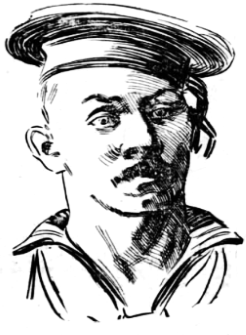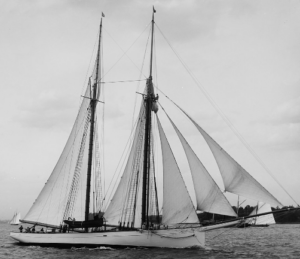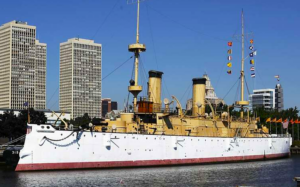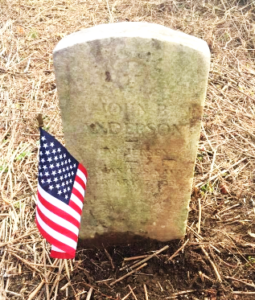Title: Navy Seaman, Spanish-American War
Birthdate: July 13, 1866
Death Date: February 7, 1926
Plot Location: Section 203, Lot 18, southwest quarter

This is the story of both father and son, because life on the sea was the legacy of John Bruce Anderson’s ancestors. His grandfather, John, was a sea captain who brought the family from Denmark to America on one of his many voyages. John’s father was given the name John Bruce Crozier Anderson, and sailing was his career as well.
The Father
John B.C. Anderson was born in 1842 in Philadelphia and he married Mary Ann French in 1863. Their first child was born the following year but died after 10 months.
Their second child was John Bruce, followed by his brother Harry. Both were baptized at the appropriately-named Mariners Presbyterian Church. A few years later the church started the Seamen’s and Landsmen’s Aid Society. Its mission was similar to the YMCA of that era but specifically for the “spiritual, moral and temporal welfare” of the crews of visiting ships.
John B.C. Anderson was a life-long mariner who also sailed  yachts competitively. He was sail master on an ocean racer called the Coronet, shown here. It won a highly publicized trans-Atlantic race against another yacht in 1887. The event was so popular the New York Times devoted its entire first page on March 28 to that one story.
yachts competitively. He was sail master on an ocean racer called the Coronet, shown here. It won a highly publicized trans-Atlantic race against another yacht in 1887. The event was so popular the New York Times devoted its entire first page on March 28 to that one story.
Mary Ann added two girls and two more boys to the Anderson family. In 1883 she gave birth for the last time, to twin girls who both died that same day. Mary Ann’s grief must have been overwhelming, especially if her husband was away at sea. In 1887, just one week after her husband won that yacht race, their five-year-old daughter, Kate, died of “cerebral congestion and convulsions.” She was the first in the family to be buried at Mount Moriah.
The Son
Young John wasted no time getting his sea legs, joining the Navy on July 15, 1895. His boarded his first ship, the USS Detroit, as a landsman, the entry-level rank for someone with no sea experience. Unfortunately, he had to experience great sadness while at sea. First, his role-model father died in the spring of 1896. Nine months after that his mother died. If John hadn’t loved his career as he did, he certainly would have felt like he was suddenly set adrift without an anchor.
A short time later he was assigned to Commodore George Dewey’s flagship of the Asiatic Fleet, the USS Olympia off the coast of China. The United States declared war on Spain in April of 1898, and John was present at the Battle of Manila Bay on May 1.
In that engagement, Spanish naval forces in the Philippines were handed a crushing defeat, securing the Philippines for the United States. It also secured the nation’s role as a major force, not only in the Pacific, but in world affairs. Dewey’s command to the ship’s captain that day became a popular slogan when it was shortened to “fire when ready, Gridley.”
In 1899 the ship was decommissioned and Seaman Anderson was discharged. A fellow crew member on the Olympia, Gus Teytand, is also buried here at Mount Moriah. He was awarded the Medal of Honor while aboard another ship a few years later, and he also worked to save the  Olympia from the scrap heap in the 1950s. His “Notable” life story can be found here.
Olympia from the scrap heap in the 1950s. His “Notable” life story can be found here.
(The Olympia is the oldest steel US warship still afloat, the only surviving naval combatant of the Spanish-American War, and is moored here in Philadelphia at the Independence Seaport Museum. It was designated a National Historic Landmark in 1966.)
Home from the Sea
The dawn of a new century saw John settle into married life with 19-year-old Margaret Joret. She gave birth to six children, five living to adulthood. They were raised just off Oregon Ave near what is now Marconi Plaza. John’s job as listed in the 1910 census was a laborer at a coal yard, but by 1920 he was doing what his father did as a merchant mariner.
By then he was in his 50s and not the robust sailor he once was. When John died of  heart disease in 1926 he was buried in the same plot as his parents and his sister Kate. His four daughters and son had long lives, but none of them were buried here. Neither was Margaret, who had a long career as chief elevator operator at Snellenburg’s Department Store. She lived with her son the rest of her life and died in 1964.
heart disease in 1926 he was buried in the same plot as his parents and his sister Kate. His four daughters and son had long lives, but none of them were buried here. Neither was Margaret, who had a long career as chief elevator operator at Snellenburg’s Department Store. She lived with her son the rest of her life and died in 1964.

Support the Friends of Mount Moriah
Help us in our mission to restore and maintain the beautiful Mount Moriah Cemetery by donating to our cause or volunteering at one of our clean-up events.

